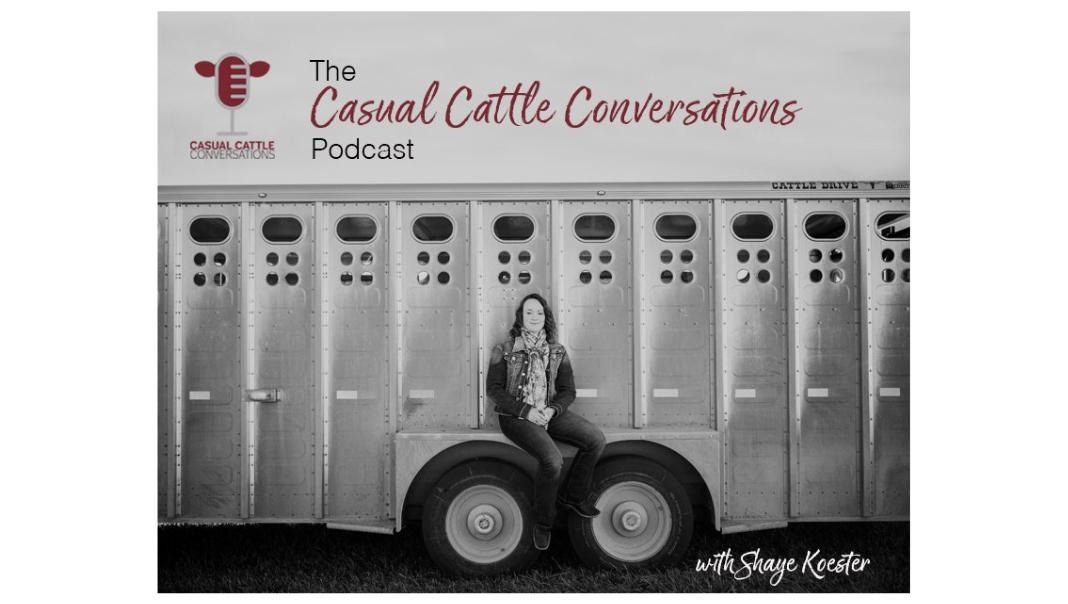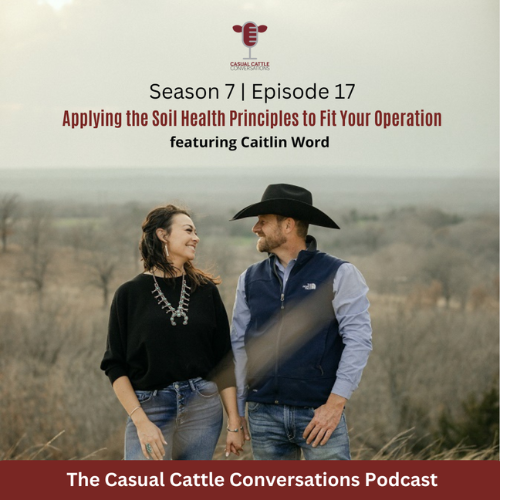The Casual Cattle Conversations Podcast: Applying the Soil Health Principles to Fit Your Operation
Thursday, April 25, 2024
Reference: Podcast Corner

Applying the Soil Health Principles to Fit Your Operation
April 22, 2024 | Written By Shaye Koester
In Season 7, Episode 17 of the Casual Cattle Conversations podcast, Caitlin Word shares how cattle producers in all regions with different goals can regenerate their natural resources by being observant and applying the following soil health principles:
1. Know Your Context
2. Cover the Soil
3. Minimize Soil Disturbance
4. Increase Diversity
5. Maintain Continuous Living Plants/Roots
6. Integrate Livestock

Click Here to listen to Shaye's Podcast
While we discuss all of the soil health principles during our conversations, we go back to number one quite frequently. “I like to bring it back to outcomes. What outcomes are you looking for? You have to strike a balance between what you want and what nature can provide,” said Word. Caitlin walks through how different producers such as seedstock operators, those with hunting leases, stocker operators and cow-calf producers are all looking for slightly different outcomes and shares specific grazing strategies they can apply to find that balance between their desired outcome and regenerating the soil.
Seedstock Producers
Many seedstock producers are focused on developing high-performing cattle for specific environments and one of the common misconceptions about applying regenerative principles is that you must sacrifice animal performance to improve soil health. This does not have to be the case. “There are times of year when you can be a little hard on your grass and focus on the cattle because the grass has time to come back. There are also times of year you can focus on the grass and the cattle have time to come back. However, there are also times where you can’t sacrifice one or the other and you need to find that balance,” said Word. Think about what your cattle need during specific seasons of the calendar year and what your truly has to offer during those months.One example of a grazing system that seedstock producers can use is a leader/follower system. This grazing method allows you to let either the bulls or heifers you are developing graze the top third of a pasture first and then your cow herd can follow behind and graze the remainder to ensure the group of younger livestock are getting the higher quality forages.
Additionally, rotating different breeding groups could pose a challenge. Turning to technology such as artificial insemination and combining similar genetic groups and groups with similar nutrient needs are factors to consider. “The more groups you have the less rest you’ll be able to offer and the roots are going to suffer,” said Word. Consolidating wherever possible will help you increase your rest time for your paddocks.
Wildlife & Hunting Leases
Offering hunting leases is a main source or secondary source of income for many landowners. While it’s important that all cattle producers consider and plan for the wildlife that also utilizes their land, those who offer hunting opportunities put extra emphasis on the habitat that is made available. “There’s a lot of plant species that they value that cattle producers would not, but they need it for nesting areas,” said Word. Take into consideration the lifecycle and timeline your wildlife develops on and how cattle can be complementary to this process. Caitlin said, “Never manage just for the grass and cattle or just for the deer because then one will suffer. It’s about considering diversity and making sure none of the pillars of the ecosystem crumble.” Like Word said early on in our conversations, it all comes back to striking a balance.Stockers & Yearlings
Cattle producers who run stockers and yearlings are in a unique position for grazing strategies compared to those who run pairs and have cattle year-round. “Stocker operators are really focused on a high plain of nutrition to reach their targeted average daily gain, so you see a lot of them integrate cover cropping systems and focus on grazing density,” said Word. If you don’t have animals year-round, you can offer extended rest periods to your pastures and therefore graze at a higher density.Commercial Cow-Calf Operators
It’s no secret that commercial cow-calf operators have a lot going on all year long. There is always something that needs to be done and many moving parts and pieces from calving to bull turnout to weaning and everything in between. This makes adding more to a grazing plan come across as a little daunting, but in reality, working to increase your forage production is more beneficial in the long run. “Having grass gives you the opportunity to be a market maker and not a market taker,” said Word. When you have more grass available, you can be more flexible with when you market your calves, open cows or late-bred cows. One grazing strategy that Word uses herself to improve soil health and increase forage is daily moves during calving season, which isn’t as challenging as you might think if you set your paddocks up correctly and work with the cows. “I think a lot of the challenges to moving cattle a lot in a grazing system can be worked around if you are aware of what they are. There’s power in knowledge,” said Word.If you aren’t sure where you stand with your soil health or where to start with grazing, start by analyzing the number one input cost for most cow-calf producers. “A good way to look at where you are at from a grazing perspective is to look at how often you have to feed and supplement each year and look at what you can do to reduce those days,” said Word. Whether you need to work on stockpiling forage, implement cover crops, shift your production system, improve your genetics or make any other changes; find what something that will work for your environment and desired outcome to reduce days spent feeding.
Final Thoughts
At the end of the day, take it back to the basics, be honest and ask yourself, “Where do I currently stand and how can I get where I want to be.” There is no cookie-cutter approach, so take advantage of opportunities you have to try new things and customize the six soil health principles to fit your own unique operations and goals.Sign up to stay connected
- News
- Property Alerts
- Save your favourite properties
- And more!
Joining Farm Marketer is free, easy and you can opt out at any time.
